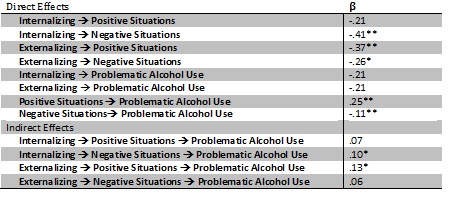The DRAM, Vol. 8(4) – Glass half empty or half full? Internalizing and externalizing pathways to risky alcohol use in DUI offenders
Research continues to investigate the influence of mental health on risky drinking and DUI offense. Evidence suggests that people with “internalizing” disorders tend to drink to cope with negative emotions, whereas those with “externalizing” disorders are more likely to drink in response to positive situations.
This week’s DRAM reviews a study that examined the influence of externalizing and internalizing disorders on first time DUI offenders’ risky drinking and perceived ability to control their drinking in different situations (Schlauch, O’Malley, Rounsaville, & Ball, 2012).
Methods
- 292 first-time DUI offenders completed questionnaires about internalizing and externalizing disorders, as well as coping self-efficacy (i.e., their perceived ability to control their drinking in different high-risk situations).
- Internalizing disorders included depression, anxiety and other disorders of negative emotionality. Externalizing disorders included conduct disorder, antisocial personality and other disorders of impulse control.
- The coping self-efficacy measured the participant’s perceived ability to cope without drinking in negative and positive situations.
- Negative situations, i.e.: “If I felt that I had let myself down”
- Positive situations, i.e.: “If I were enjoying myself at a party and wanted to feel even better”
- Researchers assessed problematic alcohol use with the Time Line Follow-Back method (TLFB: Sobell & Sobell, 1992), as well as the Addiction Severity Index (ASI: McClellan, Luborsky, O’Brien, & Woody, 1980). For analyses, they calculated the alcohol use score on the ASI, as well as how many days in the past 3 months participants drank heavily (i.e., >3 drinks for women; >4 drinks for men).
- Researchers used structural equation modeling to assess the direct and indirect relationships between variables.
Results
- Within the full model, the relationship between internalizing disorders and perceived ability to cope without drinking in negative situations was significant. There was no significant relationship between internalizing disorders and coping efficacy in positive situations or problematic alcohol use (see Figure).
- In the full model, externalizing disorders were significantly related to coping self-efficacy in both positive and negative situations, but not problematic alcohol use.
- Despite the absence of direct relationships between internalizing and externalizing disorders and problematic alcohol use, both dimensions related indirectly to problematic alcohol use through coping self-efficacy.
- Participants with high scores on internalizing were less able to cope without drinking in negative situations, which, for these participants, predicted problematic alcohol use.
- Participants with high scores on externalizing were less able to cope without drinking in positive situations, which, for these participants, predicted problematic alcohol use.

Figure. Summary of direct and indirect effects of behavioral dimensions, expectations and reported problematic alcohol use. *=p<.01; **= p<.05; Positive situations= perceived ability to cope without drinking in positive situations; Negative situations= perceived ability to cope without drinking in negative situations. Note: Internalizing, externalizing, and problematic alcohol use were all latent variables- composites constructed from multiple measures. Click image to enlarge.
Limitations
- This was a correlational study, and did not assess causality between the variables of interest. The model did not allow for the effects of risky alcohol use on behavior; for example, problematic alcohol use could potentially lead to or exacerbate anxious or conduct-disordered behavior.
- Although the Time Line Follow-Back method is validated and widely used, retrospective self-report might differ from actual drinking behavior.
Discussion
Despite evidence that psychiatric disorders are linked to DUI offense (Shaffer et al., 2007), we still do not know much about different pathways that might lead people to offend. This study suggests that DUI offenders with different types of disorder (i.e., internalizing vs. externalizing) might drink and drink to excess for different reasons. Future research is needed to determine how these different drinking pathways might influence DUI recidivism and severity.
-Kat Belkin
What do you think? Please use the comment link below to provide feedback on this article.
References
McClellan, T.A., Luborsky, L., Woody, G.E., & O’Brien, C.P. (1980). An improved diagnostic evaluation instrument for substance abuse patients: The Addiction Severity Index. The Journal of Nervous and Mental Disease, 168(1), 26-33.
Schlauch, R.C., O’Malley, S.S., Rounsaville, B.J., Ball, S.A. (2012). Internalizing and externalizing dimensions and alcohol use in first time DWI offenders: Indirect effects through coping self-efficacy. Psychology of Addictive Behaviors, 26(1), 133-139.
Shaffer, H.J., Nelson, S.E., LaPlante, D.A., LaBrie, R.A., Albanese, M., & Caro, G. (2007). The epidemiology of psychiatric disorders among repeat DUI offenders accepting a treatment-sentencing option. Journal of Consulting and Clinical Psychology, 75(5), 795-804.
Sobell, M.B., Sobell, L.C. (1992). Time line follow-back: A technique for assessing self-reported ethanol consumption. In J. Allen & R. Litten (Eds.), Measuring alcohol consumption: Psychosocial and biochemical methods (41-72). Totowa, NJ: Hummer Press.